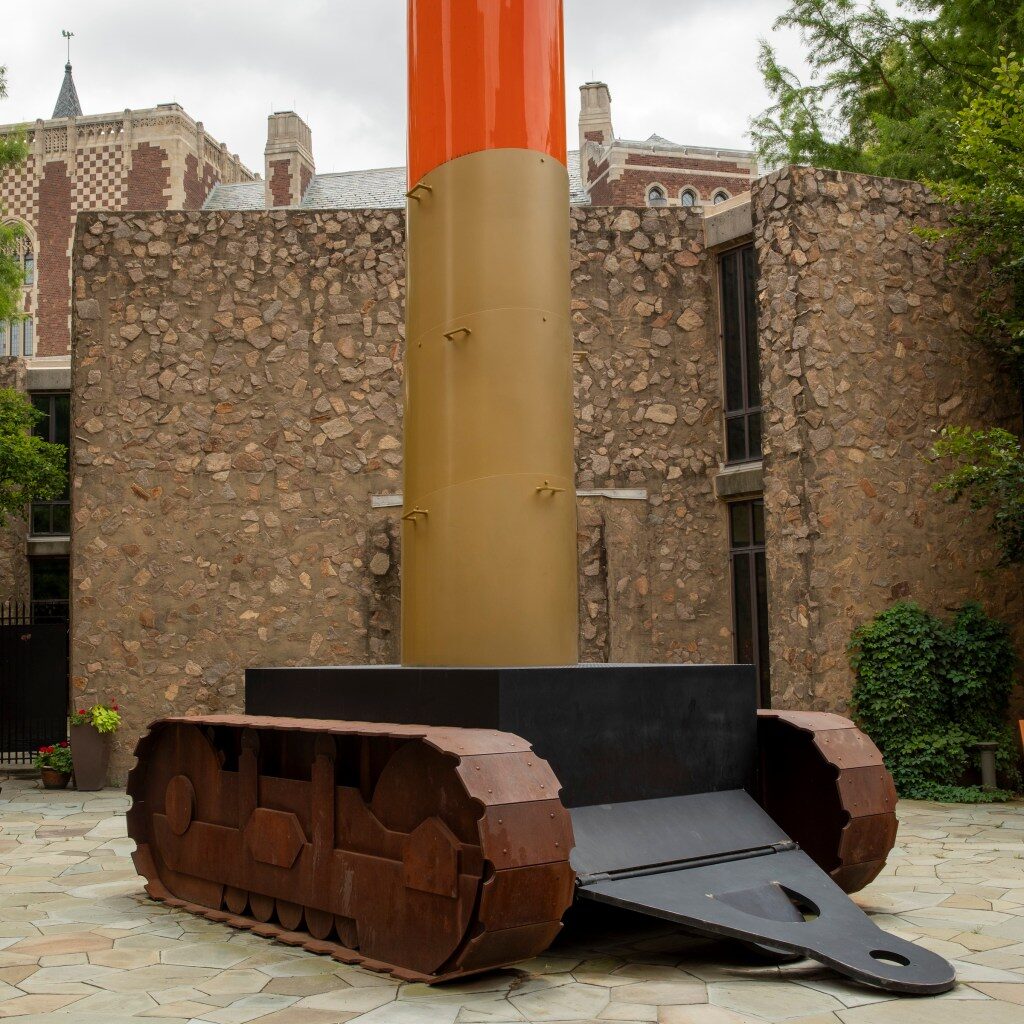A giant modern art sculpture that appeared overnight on the Yale campus in 1969 and became part of political protests and demonstrations at the university for decades will be fully restored thanks to a major arts conservation grant, the Yale University Art Gallery announced on Thursday.
Due in part to its presence at anti-war demonstrations, Claes Oldenburg’s “Lipstick (Ascending on Caterpillar Tracks)” is one of the most famous public art sculptures of the 20th century. An outdoor landmark on the Yale campus for decades, it has fallen into disrepair.
The restoration grant comes from the Bank of America Conservation Project, which funds over a dozen major art restoration projects a year and says in its mission statement that “we support this work because we believe in preserving this shared history for future generations.”
The 22-foot-tall sculpture, which when first created was two feet taller, resembles an upright tube of lipstick atop what looks like the base of an Army tank. “Lipstick (Ascending on Caterpillar Tracks)” was created in secret by Oldenburg, a 1950 graduate of Yale, with some architecture students who were at Yale in the late ‘60s. The sculpture had been officially commissioned by these students and others, as well as some faculty members including the illustrious Yale art history professor Vincent Scully. A nonprofit company called the Colossal Keepsake Corporation of Connecticut was founded in order to receive tax-deductible donations to get the sculpture built. Oldenburg, who was already a successful nationally known artist, was so enthused by the project that he offered to waive his own fee. The actual molding and fabrication process was done at Lippincott Inc., still in business today as Lippincott Sculpture and at the time based in North Haven.
“Lipstick (Ascending on Caterpillar Tracks)” was placed, without requesting advance permission from the university, in Yale’s Beinecke Plaza as a surprise “gift.”
The location was part of the artistic vision: there’s a large World War I memorial in the plaza. The walls inside the building adjacent to the plaza, Woolsey Hall, are a grand memorial to World War II. The sculpture was also placed so that Yale’s then-president Kingman Brewster couldn’t avoid seeing it when he looked out his office window.
Oldenburg was at the forefront of the ‘60s pop art movement, and “Lipstick (Ascending on Caterpillar Tracks)” was done in that style. Its amusing cosmetic/munitions mash-up purposefully offset the more austere and traditional feel of Beinecke Plaza.
Oldenburg, who died in 2022 at the age of 92, became known for his giant-sized representations of everyday objects such as a hamburger, a trowel and an electrical plug. He was also a performance artist who called his early performances “Ray Gun Theatre.”
CT museum exhibits show us where we live, how we live, how we dance and how we commune with nature
“Lipstick (Ascending) on Caterpillar Tracks” was, on a physical level, Oldenburg’s grandest work up to that time. Initially constructed with degradable wood and vinyl elements, it was removed and redone by Oldenburg and Lippincott, Inc. in 1970 with metal and fiberglass parts so it would last longer. In that first year of its existence it had already become a canvas for student graffiti, posters and outright vandalism.
The piece was immediately recognized as an artistic statement against the Vietnam War. It later became symbolic of other protests as well – Yale’s reluctance to admit women undergraduates, women’s rights, gay rights and more. The sculpture was often decorated as the centerpiece of these events.
The rules of official gift-giving were observed with the presentation of “Lipstick” to Yale, with Colossal Keepsake Corporation tendering a “deed of gift” stipulating that the university was responsible for the sculpture’s upkeep. Yale was not always the most attentive curator of the sculpture, which it chose to send on tour to other schools and museums. In 1974, through a donation mechanism, “Lipstick” was given by Yale to its own Yale Art Gallery and placed in the courtyard of the university’s Morse College dormitory area. Yale Art Gallery has provided steady upkeep for the sculpture, but constant exposure to the outdoors and natural erosion have done damage that only a full-scale restoration activity will help.
The plan which the Bank of America grant is funding involves removing the sculpture from its Yale location, dissembling it and sending its parts to art restoration professionals who will strip and repaint faded areas, use protective treatments on the metal areas and otherwise make “Lipstick” look as fresh as it did 55 years ago. It will then be brought back to Yale and be put on exhibition again.
In a statement announcing the grant, Stephanie Wiles, the Henry J. Heinz II director of the Yale University Art Gallery, said “We are deeply grateful to Bank of America for their support. This grant will enable us to restore Claes Oldenburg’s Lipstick to its former brilliance and ensure its preservation on Yale’s campus.”
Other major artworks bring restored this year by the Bank of American Art Conservation Project are Nam June Paik’s technology installation “Eagle Eye” at the Ackland Art Museum in North Carolina, cathedral windows at Saint-Chapelle in Paris, France, two murals at the Sydney Opera House in Australia and over 100 portraits of U.S. presidents at the Smithsonian’s National Portrait Gallery.
